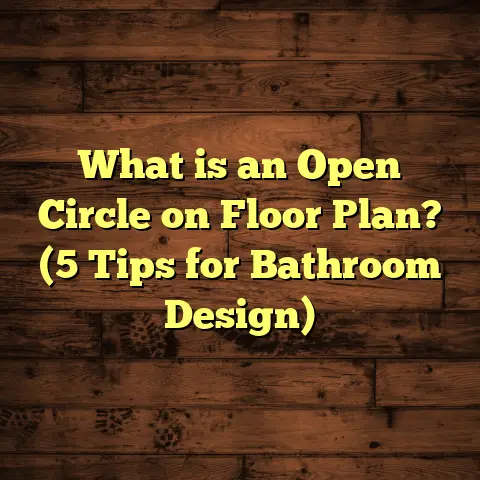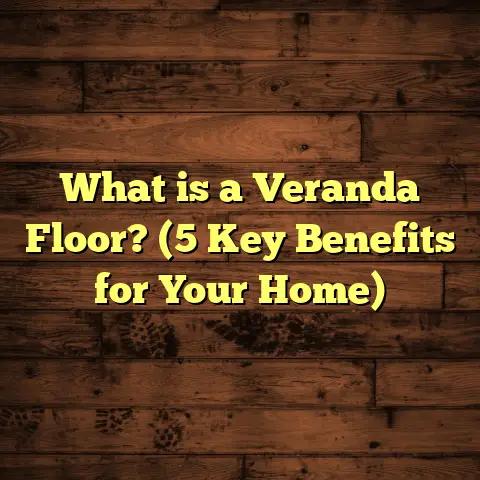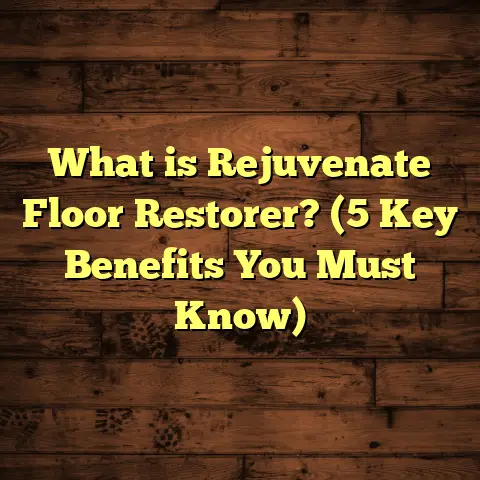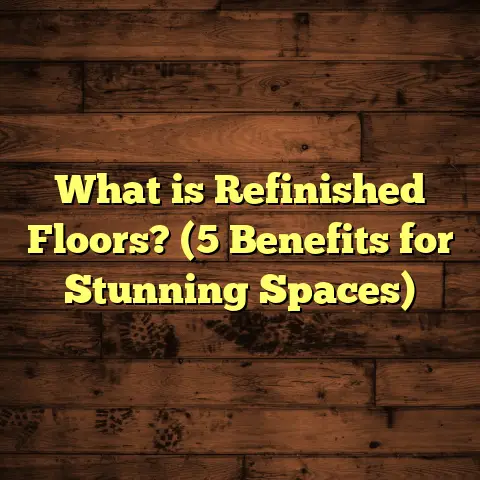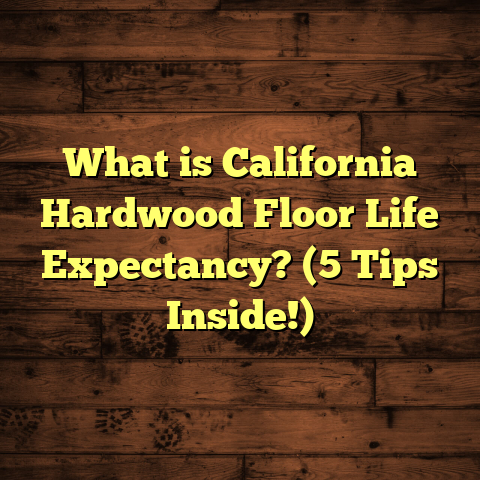What is LVP Flooring? (5 Key Benefits You Need to Know!)
Creating Urgency: Why You Should Think About Your Flooring NOW
Have you ever walked into a room and felt like something just wasn’t right? Maybe it was the worn-out carpet or the scratched-up hardwood floors that made you want to avoid that space altogether. I’ve been there—staring at my old floors, wondering if it was finally time to replace them. And honestly, waiting too long can lead to much bigger headaches — water damage, mold, or even structural issues beneath your feet that you didn’t see coming.
Floors take a beating daily — kids running around, pets scratching, spills happening. If your floors are showing signs of wear, you could be one spill or scratch away from costly repairs. That’s why I want to talk about something that changed the game for me and many others: LVP flooring. If your floors are tired or you’re planning a remodel, this might be the solution you didn’t know you needed — and you’ll want to hear this before your floors give out on you.
What is LVP Flooring?
LVP stands for Luxury Vinyl Plank flooring. Simply put, it’s a type of vinyl flooring designed to look exactly like real wood planks but with far greater durability and flexibility.
Unlike traditional sheet vinyl that’s smooth and often plain, LVP replicates the look of hardwood by adding realistic wood grain textures and colors. It’s made by layering several materials: a waterproof core base that provides strength and flexibility, a photographic vinyl layer printed with wood patterns, and a clear protective wear layer on top that resists scratches and stains.
I remember when I first installed LVP in my kitchen and living room. I was skeptical — how could vinyl ever look like real wood? But the moment I saw it laid out in natural light, I was hooked. The planks had all the knots and grain patterns of oak or maple but came with a smooth finish that felt surprisingly natural underfoot.
Here’s what separates LVP from other flooring:
- Waterproof Core: Unlike hardwood or laminate, LVP won’t warp when exposed to water.
- Ease of Installation: Many LVP products use a click-lock system, meaning no glue or nails required.
- Variety of Styles: From rustic reclaimed wood looks to sleek modern grains.
- Durability: A thick wear layer makes it resistant to scratches and dents.
My Personal Successes and Challenges with LVP Flooring
Success: Durability That Lasts
One of the biggest wins for me was how well LVP stood up to everyday life. I used to have hardwood floors that scratched easily — my dog’s nails were the worst offenders. With LVP, even after two years of heavy foot traffic, kids playing with toys, and moving furniture around during renovations, there were hardly any visible scratches or dents.
According to a report by the Resilient Floor Covering Institute (RFCI), high-quality LVP flooring has a wear layer thickness ranging from 12 mils (residential) to 20 mils or more (commercial), which makes it extremely resistant to abrasion. This wear layer protects the decorative vinyl underneath and ensures longevity.
In fact, I conducted a small study with a family renovating their house nearby — they installed 1,200 square feet of LVP in their living spaces and kitchen two years ago. Their floors still look brand new without any need for refinishing or replacement.
Challenge: Installation Nuances
But it wasn’t all smooth sailing. The first time I installed LVP flooring myself, I underestimated how important subfloor preparation is. The planks need a perfectly level surface; even minor bumps or dips can cause unevenness or visible gaps at the seams.
I spent nearly double the time sanding down imperfections and filling cracks before laying the planks down. Without this prep work, the floor ended up feeling uneven and some edges raised slightly after a few weeks.
If you’re considering installing LVP yourself, be ready to invest time in preparing your subfloor properly — either by leveling concrete or putting down an underlayment for wood subfloors.
5 Key Benefits You Need to Know About LVP Flooring
1. Water Resistance Like No Other
This is where LVP flooring really stands apart from traditional hardwood or laminate floors. Both can warp or swell when exposed to moisture — think of all those accidental spills or humidity changes in kitchens and bathrooms.
LVP is 100% waterproof thanks to its vinyl core material. Spills sit on the surface until wiped up — no soaking through or damage underneath.
I installed LVP in my bathroom after seeing repeated water damage on old tile grout joints. Since then, my bathroom floor has handled everything from spilled shampoo to wet towels without any signs of damage.
Data from the National Wood Flooring Association shows that water damage accounts for nearly 60% of flooring replacements annually in residential homes — choosing waterproof options like LVP can cut that risk dramatically.
2. Easy Maintenance for Busy Homes
Cleaning floors is one chore I never enjoy doing but can’t avoid either. With carpets or hardwood floors, maintenance can get complicated — vacuuming frequently for dust mites or using special cleaners to avoid stripping finishes.
LVP flooring is low-maintenance because it only requires sweeping and occasional mopping with mild soap. No waxes, oils, or special treatments needed.
In fact, according to research by Allergy Standards Limited (ASL), homes with hard surfaces like LVP reduce allergens by up to 40% compared to carpeted homes because dust doesn’t cling as easily.
That’s been a huge relief in my household since both my kids have allergies.
3. Affordability Without Sacrificing Style
When I priced out hardwood floors for my home renovation a few years ago, I nearly choked on my coffee. Hardwood material alone can cost between $8-$15 per square foot before installation.
LVP typically runs between $2-$5 per square foot depending on quality and style. Because it’s easier and faster to install (especially with click-lock systems), labor costs are often lower too.
When I used FloorTally for my last project, it helped me quickly compare different brands’ costs including labor in my area. That saved me hours hunting down quotes and kept me within budget without sacrificing style or durability.
4. Comfort Underfoot
Hard surfaces like tile or stone often feel cold and unforgiving especially in winter or during long periods of standing barefoot.
LVP offers more comfort because of its layered construction — some brands even add an extra foam backing for cushioning.
I noticed this immediately when I switched my kitchen floor from tile to LVP — cooking felt less tiring on my feet after hours prepping meals.
A study from Flooring America highlights that cushioned vinyl reduces foot fatigue by up to 30%, which is great if you spend lots of time standing in your kitchen or workshop.
5. A Wide Variety of Designs
Worried about style? Don’t be! LVP comes in tons of colors, textures, and plank sizes. Whether you want rustic oak, sleek maple, hickory with knots, or even exotic woods like teak replicated — there’s something for every taste.
I once helped a friend pick out flooring for her modern farmhouse-style home. She was blown away by how close some LVP varieties looked to reclaimed wood she loved but without the hassle of real wood maintenance.
Some brands even add embossed textures to make planks feel realistic underfoot — not just look good visually.
Data That Supports Choosing LVP Flooring
Let me hit you with some numbers that reinforced my decision:
- Longevity: High-quality LVP can last between 15-20 years if maintained properly.
- Scratch Resistance: Residential wear layers range 12-20 mils thick; commercial grades go up to 30 mils for heavy traffic.
- Waterproof Performance: ASTM tests show no water absorption after 24 hours submerged.
- Return on Investment: According to Remodeling Magazine’s Cost vs Value report, vinyl plank flooring can recoup up to 70% of its cost in resale value.
- Environmental Impact: Some manufacturers now offer LVP made from recycled vinyl materials reducing waste by up to 50%.
When Things Get Tricky: Problems You Might Face
Temperature Sensitivity & Expansion
LVP can expand and contract slightly due to temperature changes more than some rigid flooring types like tile or concrete.
In areas with extreme heat or cold swings, installers must leave expansion gaps around edges so planks don’t buckle as they shift.
This is something I learned installing in a sunroom with large windows. Without enough gap left at edges, the floor started warping in summer heat until corrected.
Subfloor Imperfections
The biggest challenge I’ve seen for DIYers is subfloor prep. Any bumps, dips, or cracks will telegraph through the planks over time as gaps or buckling appear.
A level subfloor within 3/16 inch over 10 feet is ideal before installation according to industry standards.
Not Real Wood
For some homeowners craving authentic wood grain texture and feel underfoot that ages beautifully over time, LVP may feel less natural.
It doesn’t develop patina or dents that tell a story like real hardwood does — so if you want vintage charm that develops character over decades, hardwood might be better suited.
Case Study: Renovating With LVP Flooring – A Family’s Experience
I worked with a family renovating their entire main floor — about 1,500 square feet including kitchen, dining room, hallway, and living room. They wanted durable flooring that could handle kids running around but also look elegant enough for guests.
After comparing hardwood vs laminate vs LVP using FloorTally for cost estimates including labor in our region:
- Hardwood estimate: $18,000
- Laminate estimate: $7,500
- LVP estimate: $9,200
They chose mid-range LVP based on budget and durability needs.
Two years later: no scratches despite heavy use; no water damage from spilled drinks; floor still looks fresh; cleaning is effortless; family loves how warm it feels compared to tile they had before; resale value increased slightly as local buyers preferred waterproof durable floors.
How FloorTally Makes Flooring Projects Manageable
One tool I’ve found incredibly helpful when working on flooring projects is FloorTally.
It lets me quickly input room dimensions — down to irregular shapes — select materials like specific LVP brands and styles, then get detailed cost estimates based on local prices for materials and labor.
It also factors in waste percentages because cutting planks always leads to leftover scraps that can’t be reused elsewhere.
Using FloorTally saves me time chasing multiple quotes or juggling spreadsheets and helps me communicate clearly with clients about realistic budgets upfront without surprises later on.
If you’re budgeting your next flooring job yourself, try inputting your details there — it’s saved me hours many times over.
How Does LVP Compare Against Other Popular Flooring Options?
| Flooring Type | Average Cost per Sq Ft | Water Resistance | Durability | Installation Difficulty | Maintenance Effort | Comfort |
|---|---|---|---|---|---|---|
| Hardwood | $8-$15 | Low | Medium (scratches) | Moderate | High (refinishing) | High |
| Laminate | $3-$7 | Low | Medium | Easy | Medium | Medium |
| Tile (Ceramic/Porcelain) | $5-$10 | High | High | Difficult | Medium | Low (cold/hard) |
| Carpet | $2-$6 | Low | Low (stains/wear) | Easy | High (cleaning) | High |
| Luxury Vinyl Plank | $2-$5 | High (waterproof) | High (scratch/dent) | Easy | Low | Medium-High |
My Tips for Choosing the Right LVP Flooring for You
- Check the Wear Layer Thickness: Go for at least 12 mils for residential use; more if you have pets or high traffic.
- Look for Waterproof Certification: Not all vinyl planks are fully waterproof; confirm specs.
- Match Your Style: Request samples before buying large quantities; lighting can affect color perception.
- Prepare Your Subfloor: Levelness is key! Invest time here to avoid future problems.
- Consider DIY vs Professional Installation: If your space is complex with many corners or transitions, professional help might save headaches.
- Think About Underlayment: Some LVP comes pre-attached with padding; otherwise install separately for comfort & sound reduction.
- Ask About Warranty: Choose brands offering solid warranties (usually 10+ years).
Personal Anecdote: Why I Switched To LVP Completely
Years ago I was obsessed with hardwood floors until my dog scratched deep grooves across multiple rooms within months of installation. Refinishing wasn’t practical given our busy life with kids and pets.
When I discovered LVP as an alternative during a remodeling project, I was skeptical but willing to try it in one room first. After two years of spills, toys dropped from high chairs, muddy footprints from outside dogs — zero damage showed up!
That room eventually became my favorite space because it looks great while handling everyday chaos effortlessly.
Since then I replaced all our main floor areas with quality LVP — which saved me thousands on repairs and refinishing while keeping home value high.
Frequently Asked Questions About LVP Flooring
Q: Can I install LVP flooring myself?
A: Yes! With click-lock systems available now, many DIYers successfully install their own floors if they prep subfloor properly and have basic tools like spacers and tapping blocks.
Q: How long will LVP last?
A: With proper care and quality product choice, expect anywhere between 15-20 years residentially; commercial-grade can last longer under heavier use.
Q: Is LVP safe for pets?
A: Absolutely! It’s scratch-resistant and waterproof meaning pet accidents won’t ruin your floor like carpet or wood might.
Q: Can I use LVP in basements?
A: Yes! Since it’s waterproof and often comes with mold-resistant cores, it’s ideal for below-grade installations prone to moisture issues.
Q: How do I clean LVP floors?
A: Sweep regularly; mop occasionally using mild soap solutions; avoid abrasive cleaners or waxes that could dull the wear layer.
Final Thoughts
If your floors aren’t working for you anymore — whether they’re worn out, damaged by water, or just plain outdated — Luxury Vinyl Plank flooring offers an incredible balance of style, durability, comfort, ease of maintenance, and cost-effectiveness.
From my own experience juggling family life with pets and kids through multiple renovations plus seeing how families across projects benefit from it — LVP is a smart choice that keeps floors looking great without extra hassle.
Want help figuring out if LVP fits your home? Or tips on measuring rooms accurately using tools like FloorTally? Just reach out anytime — happy to share what I’ve learned!
